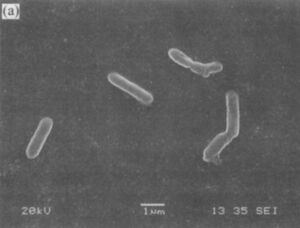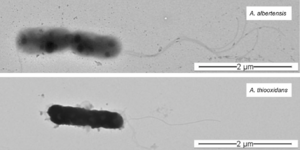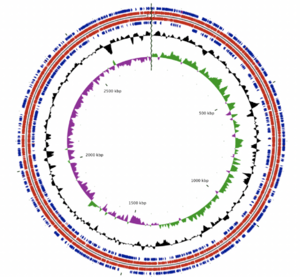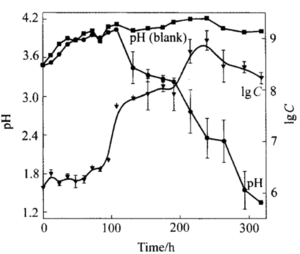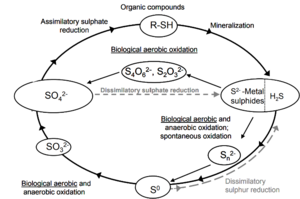Acidithiobacillus albertensis: Difference between revisions
| (31 intermediate revisions by 2 users not shown) | |||
| Line 1: | Line 1: | ||
{{Uncurated}} | {{Uncurated}} | ||
[[File:albert_morphology.jpg|thumb||right|Electron micrograph of ''A. albertensis''. From Xia et al., 2006]] | |||
==Classification== | ==Classification== | ||
Bacteria; Proteobacteria; Acidithiobacillia; Acidithiobacillales; Acidithiobacillaceae; ''Acidithiobacillus'' | |||
===Species=== | ===Species=== | ||
| Line 12: | Line 16: | ||
''Acidithiobacillus albertensis'' | ''Acidithiobacillus albertensis'' | ||
[[File:Flagella_compare.png|thumb||right|The differences in flagella between ''A. albertensis'' and ''A. thiooxidans''. SEM from Castro et al., 2017, edited by Rose Schnabel]] | |||
===Phylogenetic Debate=== | |||
When ''A. albertensis'' was initially discovered in Alberta, Canada in 1983, it was reported as a new species within the genus Acidithiobacillus. Multiple studies supported this classification, demonstrating that ''A. albertensis'' could be distinguished from ''A. thiooxidans'' by its multiple flagella, more narrow pH range (2.5 - 5.5 for ''A. albertensis'' vs 0.5 - 5.5 for ''A. thiooxidans''), and higher mol % G + C content (62 vs 52). However, in 2017, Castro et al. published a draft genome sequence of the DSM 14366 strain of ''A. albertensis'' based on 16s rRNA that challenged this classification. | |||
They reported that ''A. albertensis'' had a 97.4% average nucleotide identity value when compared to ''A. thiooxidans'' and the two genomes had an in-silico DNA-DNA hybridization index of 82.9%. Values above 95% and 70%, respectively, for these two tests suggest that the genomes being tested belong to the same species. So, Castro et al. concluded that, “''A. albertensis'' and ''A. thiooxidans'' probably comprise a single genospecies.” As of April 2024, NCBI classifies the two as separate species. | |||
==Description and Significance== | ==Description and Significance== | ||
''A. albertensis'' is a motile, rod-shaped, Gram-negative bacterium. It is an extremophile typically found in coal deposits and acid mine drainage. To survive in these harsh conditions, the bacterium has a glycocalyx made of proteoglycans, glycoproteins, and glycolipids that allows it to adhere to rocks, minerals and other substances in its environment. ''A. Albertensis'' also has a distinctive tuft of polar flagella that controls the microbe's chemical sensing and movement. Sulfur and minerals attach to this polar head and are taken up by the bacterium, giving the appearance of white or yellow sulfide pockets within the bacterial cell. | |||
Similar to the other species in this genus, ''A. albertensis'' can oxidize reduced inorganic sulfur compounds. It is used in bioleaching to separate metal ions from metal sulfides, generating sulfuric acid in the process. As such, it can be a powerful tool for metal extraction but also a threat to the acid-sensitive biomes that surround it. | |||
==Genome Structure== | ==Genome Structure== | ||
[[File:Albertensis_genome.png|thumb||right|The ''A. albertensis'' genome consists of a single, circular chromosome]] | [[File:Albertensis_genome.png|thumb||right|The ''A. albertensis'' genome consists of a single, circular chromosome. From Castro et al., 2017]] | ||
The ''A. albertensis'' genome is made of 3.5 Mbp organized into a single, circular chromosome. It contains 3203 genes, 3149 of which are predicted to be protein-coding. Castro et al. report that 63.4% of these genes have known functions, while the other 36.6% were hypothetical or unknown. Those with known functions include suites of genes for sulfur oxidation, carbon dioxide fixation, nitrate/nitrite assimilation and urea hydrolysis in addition to structural and housekeeping genes. | The ''A. albertensis'' genome is made of 3.5 Mbp organized into a single, circular chromosome. It contains 3203 genes, 3149 of which are predicted to be protein-coding. Castro et al. report that 63.4% of these genes have known functions, while the other 36.6% were hypothetical or unknown. Those with known functions include suites of genes for sulfur oxidation, carbon dioxide fixation, nitrate/nitrite assimilation and urea hydrolysis in addition to structural and housekeeping genes. | ||
| Line 24: | Line 37: | ||
====Flagella==== | ====Flagella==== | ||
Other genetic differences between ''A. albertensis'' and ''A. thiooxidans'' are due to non-synonymous single nucleotide polymorphisms in 9 genes related to flagellar structure and patterns. These mutations are likely why ''A. albertensis'' has multiple flagella while ''A. thiooxidans'' has only one. | Other genetic differences between ''A. albertensis'' and ''A. thiooxidans'' are due to non-synonymous single nucleotide polymorphisms in 9 genes related to flagellar structure and patterns. These mutations are likely why ''A. albertensis'' has multiple flagella while ''A. thiooxidans'' has only one. ''A. albertensis'' also has more genes associated with chemotaxis than ''A. thiooxidans'', meaning that it may be able to detect and respond to chemical cues in the environment differently than ''A. thiooxidans'', a particularly important skill for survival in ever-changing mining conditions. | ||
==Cell Structure, Metabolism and Life Cycle== | ==Cell Structure, Metabolism and Life Cycle== | ||
Although the major substrates for the metabolism of ''A. albertensis'' have been identified as reduced inorganic sulfide compounds(RISCs), thiosulfates, tetrathionates, and elemental sulfur, the metabolic pathway through which the bacteria oxidizes these compounds to derive energy is not fully determined, with this being partially due to difficulties with the study of ''A. albertensis'' proteins. For examination of protein structure and function within bacteria, some common tests used for this purpose include but are not limited to functional complementation, mutagenesis, and cloning. However, these tests are optimized for function at neutral conditions, so since ''A. albertensis'' has been demonstrated to have an optimal pH for growth between 3.5-4.0, these tests are not functional. Furthermore, many proteins from the bacteria can not be examined by transduction followed by expression of ''A. albertensis'' proteins within other bacteria such as ''E. coli'', as ''E. coli'' grows in neutral conditions in which the proteins of ''A. albertensis'' do not fold properly. | |||
===Debates over general sulfur oxidation mechanism of ''A. albertensis''=== | |||
Although the complete metabolic pathway for ''A. albertensis'' has not been fully determined, various methods have been proposed. Initially, the two major mechanisms that were proposed were a direct and an indirect oxidation. The direct mechanism stated that enzymes within the bacteria would directly oxidize sulfur in the substrate, then would reduce other compounds to reoxidize itself. The indirect mechanism proposes that ''A. albertensis'' utilized Fe 3+ ions to oxidize the sulfur containing compounds, then ''A. albertensis'' oxidizes Fe 2+ generated to Fe 3+ to restore the primary oxidant. However, since no enzymes that would catalyze the direct mechanism have been discovered, the indirect mechanism is widely accepted. | |||
[[File:A. albertensis pH and c vs t.png|thumb||right|Graph demonstrating the pH and cell growth of ''A. albertensis'' strain BY-05 in thiosulfate containing media]] | |||
====Two different indirect mechanisms==== | |||
Although many researchers agree that ''A. albertensis'' oxidizes sulfur through the indirect oxidation mechanism, two distinct indirect mechanisms have been proposed, the thiosulfate and polysulfide oxidation. Within the polysulfide oxidation, it is suggested that ''A. albertensis'' oxidizes metal sulfides to a polysulfide, and then continues to oxidize it to the final product, sulfate. The thiosulfate oxidative pathway suggests that the bacteria first oxidizes sulfides to thiosulfate, then continues to oxidize it through the intermediates of tetrathionate, sulfonic acid, trithionate, to the end product of sulfate. | |||
It has not been fully determined, but experimental evidence suggests that ''A. albertensis'' oxidizes sulfides through the thiosulfate pathway. When the ''A. albertensis'' strain BY-05 was grown in thiosulfate-containing media, the formation of white deposits as well as an initial increase of the media pH was observed, followed by the continual decrease of pH as the cells continued proliferation. The formation of white deposits indicates the presence of tetrathionate, an intermediate of the thiosulfate pathway, and the oxidation of thiosulfate to tetrathionate releases basic NaOH, leading to an initial increase of the pH of the media. Once thiosulfate stores are depleted, ''A. albertensis'' continues to oxidize the tetrathionate to sulfates, which is converted to sulfuric acid, leading to the decrease in pH observed. | |||
==Ecology and Pathogenesis== | ==Ecology and Pathogenesis== | ||
''A. albertensis'' has been found to grow under extreme conditions, and due to it being a chemolithoautotroph that fixates Carbon from CO2 and deriving energy from the oxidation of sulfur containing compounds, this allows ''A. albertensis'' to grow in seemingly rough ecosystems, such as in mine waste or oceanic ecosystems. | |||
[[File:A. albertensis sulfur cycle.png|thumb||right|A representation of the sulfur cycle in the environment, with the oxidative roles that ''A. albertensis'' catalyzes underlined.]] | |||
===''A. albertensis'' role within the environment=== | |||
Within the environment, ''A. albertensis'' plays a crucial role in various steps of the sulfur cycle. Sulfur is a crucial element that is used for a variety of roles, such as acting as an electron donor or acceptor, forming minerals, and being incorporated into various biological molecules such as amino acids including cysteine and methionine. The importance of sulfur within the environment requires that sulfur is continually cycled through various oxidation states, and ''A. albertensis'' plays a role in this cycling, helping carry out the dissimilatory oxidation steps within the cycle, and allowing for the generation of oxidated sulfur compounds that can be used for a variety of metabolic processes by other organisms. | |||
===''A. albertensis'' deleterious effect on environment=== | |||
The oxidation of sulfur compounds by the metabolism of ''A. albertensis'' has numerous important applications in various industries as it generates metal ions and sulfuric acid which can be separated to extract the metal from reduced compounds. However, these products of ''A. albertensis'' metabolism are dangerous to the environment, as sulfuric acid is an incredibly strong acid and metal ions are strongly toxic to humans, animals, bacteria, and plants. As such, when large amounts of sulfur oxidizing bacteria build up, the byproducts of their metabolism build up as well and have been demonstrated to cause catastrophic ecological changes. One instance demonstrating this occured at the Iron Mountain mine in 1967, where large growths of sulfur oxidizing bacteria led to drastic acidification of the water within the mine as well as the formation of nearly 300 tonnes of metal ions. This acidic, metal ion containing water contaminated the nearby Sacramento River, and the large inflow of acid and metal ions led to a drastic disturbance of the ecosystem. | |||
===Pathogenicity=== | |||
''Acidithiobacillus albertensis'' has no reported pathogenicity. | |||
==References== | ==References== | ||
“Chalcopyrite.” Encyclopædia Britannica, Encyclopædia Britannica, inc., www.britannica.com/science/chalcopyrite. | [1] “Chalcopyrite.” Encyclopædia Britannica, Encyclopædia Britannica, inc., www.britannica.com/science/chalcopyrite. | ||
Castro, M., et al. “Draft genome sequence of the type strain of the sulfur-oxidizing acidophile, Acidithiobacillus albertensis (DSM 14366)”. Standards in genomic sciences. 2017. Volume 12 p. 77-84. | [2] Castro, M., et al. “Draft genome sequence of the type strain of the sulfur-oxidizing acidophile, Acidithiobacillus albertensis (DSM 14366)”. Standards in genomic sciences. 2017. Volume 12 p. 77-84. | ||
Chen, J., Liu, Y., Diep, P., Mahadevan, R. “Genetic engineering of extremely acidophilic Acidithiobacillus species for biomining: Progress and perspectives”. Journal of Hazardous Materials. 2022. Volume 438 p. 129-247. | [3] Chen, J., Liu, Y., Diep, P., Mahadevan, R. “Genetic engineering of extremely acidophilic Acidithiobacillus species for biomining: Progress and perspectives”. Journal of Hazardous Materials. 2022. Volume 438 p. 129-247. | ||
Moya-Beltrán, A., Beard, S., Rojas-Villalobos, C. et al. “Genomic evolution of the class Acidithiobacillia: deep-branching Proteobacteria living in extreme acidic conditions”. ISME J. 2021. Volume 15 p. 3221–3238. | [4] Moya-Beltrán, A., Beard, S., Rojas-Villalobos, C. et al. “Genomic evolution of the class Acidithiobacillia: deep-branching Proteobacteria living in extreme acidic conditions”. ISME J. 2021. Volume 15 p. 3221–3238. | ||
Moya-Beltrán, A., Gajdosik, M., Rojas-Villalobos, C. et al. “Influence of mobile genetic elements and insertion sequences in long- and short-term adaptive processes of Acidithiobacillus ferrooxidans strains”. Sci Rep. 2023.Volume 13 p. 10876-10890. | [5] Moya-Beltrán, A., Gajdosik, M., Rojas-Villalobos, C. et al. “Influence of mobile genetic elements and insertion sequences in long- and short-term adaptive processes of Acidithiobacillus ferrooxidans strains”. Sci Rep. 2023.Volume 13 p. 10876-10890. | ||
Rzhepishevska, O. “Physiology and Genetics of Acidithiobacillus Species: Applications for Biomining”. Umeå University. 2023. | [6] Rzhepishevska, O. “Physiology and Genetics of Acidithiobacillus Species: Applications for Biomining”. Umeå University. 2023. | ||
Schofield, E. “Acid Rock Drainage: More than Just a Mining Project Concern?” Barr Engineering Co., 2023. www.barr.com/Insights/Insights-Article/ArtMID/1344/ArticleID/380/Acid-rock-drainage-More-than-just-a-mining-project-concern. | [7] Schofield, E. “Acid Rock Drainage: More than Just a Mining Project Concern?” Barr Engineering Co., 2023. www.barr.com/Insights/Insights-Article/ArtMID/1344/ArticleID/380/Acid-rock-drainage-More-than-just-a-mining-project-concern. | ||
“Section 3 - Acidithiobacillus: Safety Assessment of Transgenic Organisms”. OECD. 2006. Volume 2. | [8] “Section 3 - Acidithiobacillus: Safety Assessment of Transgenic Organisms”. OECD. 2006. Volume 2. | ||
“Tetrathionate.” Wikipedia, Wikimedia Foundation, 27 Aug. 2023, en.wikipedia.org/wiki/Tetrathionate. | [9] “Tetrathionate.” Wikipedia, Wikimedia Foundation, 27 Aug. 2023, en.wikipedia.org/wiki/Tetrathionate. | ||
Vardanyan, N.S., and A.K. Vardanyan. “New sulphur oxidizing bacteria isolated from bioleaching pulp of zinc and copper concentrates.” Universal Journal of Microbiology Research. 2014. Volume 2 p. 27–31. | [10] Vardanyan, N.S., and A.K. Vardanyan. “New sulphur oxidizing bacteria isolated from bioleaching pulp of zinc and copper concentrates.” Universal Journal of Microbiology Research. 2014. Volume 2 p. 27–31. | ||
Xia, J., et al. “A new strain acidithiobacillus albertensis by-05 for bioleaching of metal sulfides ores.” Transactions of Nonferrous Metals Society of China. 2007. Volume 17 p. 168–175. | [11] Xia, J., et al. “A new strain acidithiobacillus albertensis by-05 for bioleaching of metal sulfides ores.” Transactions of Nonferrous Metals Society of China. 2007. Volume 17 p. 168–175. | ||
==Author== | ==Author== | ||
Latest revision as of 01:58, 26 April 2024
Classification
Bacteria; Proteobacteria; Acidithiobacillia; Acidithiobacillales; Acidithiobacillaceae; Acidithiobacillus
Species
|
NCBI: [1] |
Acidithiobacillus albertensis
Phylogenetic Debate
When A. albertensis was initially discovered in Alberta, Canada in 1983, it was reported as a new species within the genus Acidithiobacillus. Multiple studies supported this classification, demonstrating that A. albertensis could be distinguished from A. thiooxidans by its multiple flagella, more narrow pH range (2.5 - 5.5 for A. albertensis vs 0.5 - 5.5 for A. thiooxidans), and higher mol % G + C content (62 vs 52). However, in 2017, Castro et al. published a draft genome sequence of the DSM 14366 strain of A. albertensis based on 16s rRNA that challenged this classification.
They reported that A. albertensis had a 97.4% average nucleotide identity value when compared to A. thiooxidans and the two genomes had an in-silico DNA-DNA hybridization index of 82.9%. Values above 95% and 70%, respectively, for these two tests suggest that the genomes being tested belong to the same species. So, Castro et al. concluded that, “A. albertensis and A. thiooxidans probably comprise a single genospecies.” As of April 2024, NCBI classifies the two as separate species.
Description and Significance
A. albertensis is a motile, rod-shaped, Gram-negative bacterium. It is an extremophile typically found in coal deposits and acid mine drainage. To survive in these harsh conditions, the bacterium has a glycocalyx made of proteoglycans, glycoproteins, and glycolipids that allows it to adhere to rocks, minerals and other substances in its environment. A. Albertensis also has a distinctive tuft of polar flagella that controls the microbe's chemical sensing and movement. Sulfur and minerals attach to this polar head and are taken up by the bacterium, giving the appearance of white or yellow sulfide pockets within the bacterial cell.
Similar to the other species in this genus, A. albertensis can oxidize reduced inorganic sulfur compounds. It is used in bioleaching to separate metal ions from metal sulfides, generating sulfuric acid in the process. As such, it can be a powerful tool for metal extraction but also a threat to the acid-sensitive biomes that surround it.
Genome Structure
The A. albertensis genome is made of 3.5 Mbp organized into a single, circular chromosome. It contains 3203 genes, 3149 of which are predicted to be protein-coding. Castro et al. report that 63.4% of these genes have known functions, while the other 36.6% were hypothetical or unknown. Those with known functions include suites of genes for sulfur oxidation, carbon dioxide fixation, nitrate/nitrite assimilation and urea hydrolysis in addition to structural and housekeeping genes.
Plasmids and other mobile genetic elements (MGEs) make up 16.2% of the A. albertensis genome and are the main source of genetic difference between A. albertensis and A. thiooxidans. These MGEs encode genes related to sulfur oxidation, nitrate reduction and urea transport, among others. According to Castro et al. (2017): these genes "could confer adaptive advantages to A. albertensis over A. thiooxidans strains under nitrogen and oxygen limitation and/or under extremely low pH."
Flagella
Other genetic differences between A. albertensis and A. thiooxidans are due to non-synonymous single nucleotide polymorphisms in 9 genes related to flagellar structure and patterns. These mutations are likely why A. albertensis has multiple flagella while A. thiooxidans has only one. A. albertensis also has more genes associated with chemotaxis than A. thiooxidans, meaning that it may be able to detect and respond to chemical cues in the environment differently than A. thiooxidans, a particularly important skill for survival in ever-changing mining conditions.
Cell Structure, Metabolism and Life Cycle
Although the major substrates for the metabolism of A. albertensis have been identified as reduced inorganic sulfide compounds(RISCs), thiosulfates, tetrathionates, and elemental sulfur, the metabolic pathway through which the bacteria oxidizes these compounds to derive energy is not fully determined, with this being partially due to difficulties with the study of A. albertensis proteins. For examination of protein structure and function within bacteria, some common tests used for this purpose include but are not limited to functional complementation, mutagenesis, and cloning. However, these tests are optimized for function at neutral conditions, so since A. albertensis has been demonstrated to have an optimal pH for growth between 3.5-4.0, these tests are not functional. Furthermore, many proteins from the bacteria can not be examined by transduction followed by expression of A. albertensis proteins within other bacteria such as E. coli, as E. coli grows in neutral conditions in which the proteins of A. albertensis do not fold properly.
Debates over general sulfur oxidation mechanism of A. albertensis
Although the complete metabolic pathway for A. albertensis has not been fully determined, various methods have been proposed. Initially, the two major mechanisms that were proposed were a direct and an indirect oxidation. The direct mechanism stated that enzymes within the bacteria would directly oxidize sulfur in the substrate, then would reduce other compounds to reoxidize itself. The indirect mechanism proposes that A. albertensis utilized Fe 3+ ions to oxidize the sulfur containing compounds, then A. albertensis oxidizes Fe 2+ generated to Fe 3+ to restore the primary oxidant. However, since no enzymes that would catalyze the direct mechanism have been discovered, the indirect mechanism is widely accepted.
Two different indirect mechanisms
Although many researchers agree that A. albertensis oxidizes sulfur through the indirect oxidation mechanism, two distinct indirect mechanisms have been proposed, the thiosulfate and polysulfide oxidation. Within the polysulfide oxidation, it is suggested that A. albertensis oxidizes metal sulfides to a polysulfide, and then continues to oxidize it to the final product, sulfate. The thiosulfate oxidative pathway suggests that the bacteria first oxidizes sulfides to thiosulfate, then continues to oxidize it through the intermediates of tetrathionate, sulfonic acid, trithionate, to the end product of sulfate.
It has not been fully determined, but experimental evidence suggests that A. albertensis oxidizes sulfides through the thiosulfate pathway. When the A. albertensis strain BY-05 was grown in thiosulfate-containing media, the formation of white deposits as well as an initial increase of the media pH was observed, followed by the continual decrease of pH as the cells continued proliferation. The formation of white deposits indicates the presence of tetrathionate, an intermediate of the thiosulfate pathway, and the oxidation of thiosulfate to tetrathionate releases basic NaOH, leading to an initial increase of the pH of the media. Once thiosulfate stores are depleted, A. albertensis continues to oxidize the tetrathionate to sulfates, which is converted to sulfuric acid, leading to the decrease in pH observed.
Ecology and Pathogenesis
A. albertensis has been found to grow under extreme conditions, and due to it being a chemolithoautotroph that fixates Carbon from CO2 and deriving energy from the oxidation of sulfur containing compounds, this allows A. albertensis to grow in seemingly rough ecosystems, such as in mine waste or oceanic ecosystems.
A. albertensis role within the environment
Within the environment, A. albertensis plays a crucial role in various steps of the sulfur cycle. Sulfur is a crucial element that is used for a variety of roles, such as acting as an electron donor or acceptor, forming minerals, and being incorporated into various biological molecules such as amino acids including cysteine and methionine. The importance of sulfur within the environment requires that sulfur is continually cycled through various oxidation states, and A. albertensis plays a role in this cycling, helping carry out the dissimilatory oxidation steps within the cycle, and allowing for the generation of oxidated sulfur compounds that can be used for a variety of metabolic processes by other organisms.
A. albertensis deleterious effect on environment
The oxidation of sulfur compounds by the metabolism of A. albertensis has numerous important applications in various industries as it generates metal ions and sulfuric acid which can be separated to extract the metal from reduced compounds. However, these products of A. albertensis metabolism are dangerous to the environment, as sulfuric acid is an incredibly strong acid and metal ions are strongly toxic to humans, animals, bacteria, and plants. As such, when large amounts of sulfur oxidizing bacteria build up, the byproducts of their metabolism build up as well and have been demonstrated to cause catastrophic ecological changes. One instance demonstrating this occured at the Iron Mountain mine in 1967, where large growths of sulfur oxidizing bacteria led to drastic acidification of the water within the mine as well as the formation of nearly 300 tonnes of metal ions. This acidic, metal ion containing water contaminated the nearby Sacramento River, and the large inflow of acid and metal ions led to a drastic disturbance of the ecosystem.
Pathogenicity
Acidithiobacillus albertensis has no reported pathogenicity.
References
[1] “Chalcopyrite.” Encyclopædia Britannica, Encyclopædia Britannica, inc., www.britannica.com/science/chalcopyrite.
[2] Castro, M., et al. “Draft genome sequence of the type strain of the sulfur-oxidizing acidophile, Acidithiobacillus albertensis (DSM 14366)”. Standards in genomic sciences. 2017. Volume 12 p. 77-84.
[3] Chen, J., Liu, Y., Diep, P., Mahadevan, R. “Genetic engineering of extremely acidophilic Acidithiobacillus species for biomining: Progress and perspectives”. Journal of Hazardous Materials. 2022. Volume 438 p. 129-247.
[4] Moya-Beltrán, A., Beard, S., Rojas-Villalobos, C. et al. “Genomic evolution of the class Acidithiobacillia: deep-branching Proteobacteria living in extreme acidic conditions”. ISME J. 2021. Volume 15 p. 3221–3238.
[5] Moya-Beltrán, A., Gajdosik, M., Rojas-Villalobos, C. et al. “Influence of mobile genetic elements and insertion sequences in long- and short-term adaptive processes of Acidithiobacillus ferrooxidans strains”. Sci Rep. 2023.Volume 13 p. 10876-10890.
[6] Rzhepishevska, O. “Physiology and Genetics of Acidithiobacillus Species: Applications for Biomining”. Umeå University. 2023.
[7] Schofield, E. “Acid Rock Drainage: More than Just a Mining Project Concern?” Barr Engineering Co., 2023. www.barr.com/Insights/Insights-Article/ArtMID/1344/ArticleID/380/Acid-rock-drainage-More-than-just-a-mining-project-concern.
[8] “Section 3 - Acidithiobacillus: Safety Assessment of Transgenic Organisms”. OECD. 2006. Volume 2.
[9] “Tetrathionate.” Wikipedia, Wikimedia Foundation, 27 Aug. 2023, en.wikipedia.org/wiki/Tetrathionate.
[10] Vardanyan, N.S., and A.K. Vardanyan. “New sulphur oxidizing bacteria isolated from bioleaching pulp of zinc and copper concentrates.” Universal Journal of Microbiology Research. 2014. Volume 2 p. 27–31.
[11] Xia, J., et al. “A new strain acidithiobacillus albertensis by-05 for bioleaching of metal sulfides ores.” Transactions of Nonferrous Metals Society of China. 2007. Volume 17 p. 168–175.
Author
Page authored by Ben Sauer and Rose Schnabel, students of Prof. Jay Lennon at IndianaUniversity.
